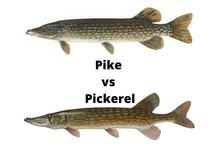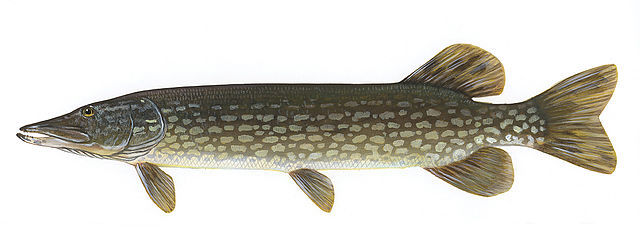This article may contain affiliate links. If you make a purchase after clicking on a link we may earn a small commission at no extra cost to you. As an Amazon Associate, I earn from qualifying purchases.
Pike vs Pickerel – What’s the Difference?

Pike and pickerel are two very similar species that are found throughout much of the North American continent. They are known as some of the most popular freshwater fish species for anglers who fish along rivers and lakes in the upper portion of the United States and Canada.
Many people mistakenly assume that pike and pickerel are the same species. In this article, we’ll explore some of the differences between pike vs pickerel, as well as other information about each species that will help when it comes to identifying each one.
Pike vs Pickerel Overview
Both the pike and pickerel species are fish that belong to the Esocidae family, which includes a range of different pike and pickerel variations, as well as the muskellunge species. Since they are found in relatively the same type of area within lakes and rivers, many people assume that pike and pickerel are the same type of fish.
Also Read: Muskie vs Pike
They share many similarities in their overall appearance and behaviors compared to other types of freshwater fish. Their long, slender body shape is designed to give them extreme levels of speed and acceleration in the water, which helps them chase down and catch small bait fish with ease.
In addition to their body profile and the way in which their fins and tail is oriented to the rest of their bodies, pike and pickerel also have many similarities in the way their bodies are marked and colored.
They each have a darker-green complexion than other freshwater fish with the distinct light-colored markings that are found along the sides of the fish.
What is a Northern Pike?
The northern pike is a peculiar type of freshwater fish species found throughout North America. They have been given the name “water wolves” by biologists and anglers who are familiar with this species due to the fact that they are often found working together in packs to herd and corral their prey and devour them using a group effort.

Pike are found in North America, as well as the many freshwater lakes and rivers across Europe and Asia. While the North American pike is known to be one of the larger freshwater fish species in this part of the world, the Eurasian pike is actually much larger and can often grow to sizes of more than 40 pounds in many cases.
Also Read: What Do Pike Feed On?
Northern pike have a distinct long body with a large mouth that is lined with very sharp teeth which they use to grasp or simply devour their prey. Their body color is often dark-green, but some pikes might have darker or lighter color variations depending on the region where they are found.
Most pikes like to live in slow-moving rivers or lakes where the water is relatively shallow. They especially like to stay around weedy areas of lakes and rivers where the water is less than 4 feet in depth as this type of environment is rich with a variety of different types of bait fish, insects and other creatures that pike will eat.
What is a Pickerel?
Pickerel are very similar to the northern pike species in many ways and they actually are usually mistaken as pike in some cases. They are much smaller than both muskies or pikes when the reach full maturity, but even experienced anglers often have trouble distinguishing small pikes from their close cousins, the pickerel.

Pickerel, or chain pickerel, exist in a few different varieties that can be found throughout North America. Their habitat range stretches much further south than the pike or muskie and it’s not uncommon to find pickerel as far south as Florida and throughout the Mississippi River system.
They are very prominent throughout the southeastern United States and are also found all along the rivers and lakes of the states on the East Coast of America, as well as parts of eastern Canada.
The diet of the pickerel consists of mostly smaller fish and insects, but once they reach full maturity, they will prey on fish that might be up to half as large as their own size. Pickerels are opportunistic feeders and will strike at anything from small ducks to crawfish and mice, as well as virtually anything else they get a chance to eat on the water’s surface.
Fishing for pickerel is common throughout most of the United States as these fish are known to be feisty when hooked and will put up quite a fight against an ultralight rod and reel.
They can be caught on a huge variety of lures and baits and many bass anglers or those fishing for crappie and other panfish will often catch pickerel by mistake. Their extremely toothy mouth that’s full of needle-like teeth makes them one of the more dangerous fish to handle without pliers.
Pike vs Pickerel Size
The northern pike is one of the largest freshwater fish in North America, despite the fact that the ones found throughout America and Canada are often smaller in size than their European and Asian counterparts.
These fish commonly grow to roughly 5 or 10 pounds on average and typically measure anywhere from 24 to 32 inches in length. However, there are plenty of instances where they are known to grow to much larger sizes in the right conditions and with an optimal diet.
A trophy-size northern pike is considered to be any specimen that exceeds 20 pounds. It’s actually more common to find bigger northern pike in the far reaches of Canada such as Saskatchewan and the Northwest Territories, as well as Alaska.
The world record northern pike is one that was caught in Europe, but the biggest one ever landed in North America was recorded as being caught in New York’s Great Sacandaga Lake in 1940. The monster fish weighed in at a whopping 46-pounds, 2-ounces and measured more than 52 inches in length.
The average pickerel is known to be roughly 3 pounds and about 24 inches in length. Most anglers consider any pickerel over about 4 pounds to be trophy-size and specimens that are more than 6 pounds are viewed as extremely rare giants.
According to the IGFA, the current world record pickerel was a 9-pound, 6-ounce whopper that was caught in the southern state of Georgia in 1961. There have been stories of 10-pound pickerel in America’s Deep South, mostly because these fish are able to enjoy a warmer climate and longer growing season.
Pike vs Pickerel Differences
Despite the fact that these two fish species very closely resemble one another, there are some reliable methods you can use to tell them apart. Here are the best ways to distinguish a pike vs pickerel.
Color
In many cases, the body’s color pattern and overall shade will be very similar between a pike and pickerel. However, it is true that pickerel will have a more vibrant-yellow coloration to their spots along the sides of the fish’s body.
These spots might appear to be different shades of yellow, but most anglers can distinctly tell that the color of the spots are definitely yellow instead of gray or green.
When it comes to pikes, these spots will usually be a bit smaller, bean-shaped patterns that will have a light-green shade to them. The best way to tell the pike vs pickerel apart is to look for any yellow markings along the side.
Side Pattern
The side pattern on each type of fish, which is referenced above, will also differ between pikes and pickerel. The main difference between pike and pickerel in this regard are that pikes will often have more distinct markings along their sides with clear outlines while a pickerel’s side pattern might fade in and out.
Many pickerel are described as having vibrant yellow ‘spots’ that often have an irregular shape, yet a pike’s spots are usually described as oval or bean-shaped.
Gills and Pores Under Jaw
Most anglers are aware of the fact that northern pike and pickerel have distinct pores underneath their lower jaw. These pores are used to detect prey in many cases, but the specific number of pores on each type of fish can help you distinguish which species you’ve caught.
Northern pikes will usually have 5 sets of pores on either side of their jaw. In some cases, they might have 4 sets or even 6 sets, but the number is never less than 4 sets of pores. Pickerel, on the other hand, will usually have 3 sets or possibly 4 in rare cases.
Conclusion
It’s true that hybrid species exist between northern pike and pickerel, but these are often very difficult to distinguish between either a pike or pickerel.
It’s common for the most experienced anglers to have difficulty telling these two similar species of fish apart, so don’t expect to become a master at distinguishing pike from pickerel overnight.
By using the information we’ve provided in this article, you should have a good foundation for understanding how to tell a pike vs pickerel in your future fishing trips.
